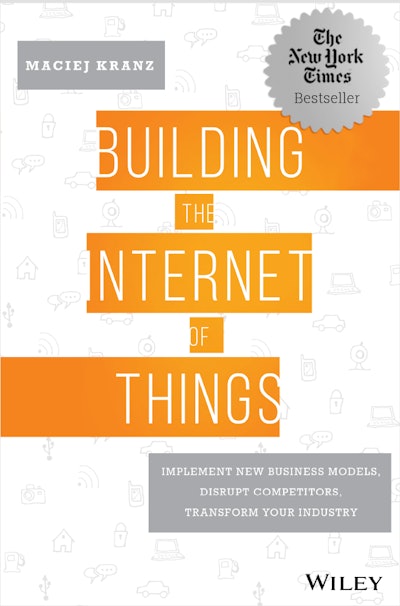
 Maciej Kranz
Maciej KranzBlockchain has emerged as a technology that allows a secure exchange of value between entities in a distributed fashion by maintaining a continuously growing list of data records that are protected from tampering and revision. The technology first appeared on most IT radar screens a few years ago in the form of Bitcoin, a virtual currency that relies on blockchain technology to ensure its security and integrity. Although Bitcoin’s future is uncertain, blockchain is a different story.
As the currency’s underlying technology, blockchain is attracting considerable attention for its ability to ensure the integrity of transactions over the network between any entities. For example, I spoke with an energy company looking at blockchain to manage the interactions between solar panels and the power grid. Automobile companies are considering the technology to authenticate connected vehicles in the V2V environment.
Among the many other uses of blockchain being considered are the ability to trace the sources of goods, increase food safety, create smart contracts, and perform audits. Blockchain, it turns out, is a natural complement to IoT security in a wide variety of use cases.
Blockchain IoT implementations are still at a proof-of-concept stage, but standards are already starting to emerge. The Linux Foundation set up the Hyperledger Project, a partnership with several dozen major technology and financial players, to hammer out an agreement on open-source blockchain standards. For now, blockchain is presented as a sort of distributed consensus system ledger or database where no one person or entity controls all of the data. In effect, blockchain creates and stores a permanent or immutable log record of every transaction.
As an emerging open standard, compliant variations of blockchain could enable products or solutions to offer different levels of control and programmable business logic via smart contracts. We’ll just have to watch and see what happens.
According to Martha Bennett, principal analyst at Forrester Research, blockchain could be a transformational technology that changes the game in banking, IoT, and beyond. “Long-term, blockchain has the potential to revolutionize distributed computing. Looking at it purely from a technical perspective, many of the projects currently underway are laying the foundation for new ways of approaching distributed computing inside and outside of banking — doing for the storage and application layer what the Internet did for the communications layer. It’s early days yet, and it will take time for all of the security, privacy, and scale issues to be addressed,” Bennett commented.
This much we know now: Blockchain, which produces and saves a distributed log of any type of transaction activity, enables people to put their trust in a “trustless” transaction environment. It essentially eliminates the need for a central trusted intermediary between buyers and sellers or, in the case of IoT, between communicating things. In fact, blockchain could potentially eliminate the need for any intermediaries in most transactions. For those who want open, trustworthy IoT communications without having to rely on intermediaries, blockchain, especially “private” blockchain, could provide the answer and enable the type of distributed IoT exchanges people have barely begun to imagine could be possible.
Machine Learning Enhances Real-Time Analytics
Like blockchain, machine learning is another important technology for IoT. It delivers a critical technology behind real-time predictive analytics, one of the key IoT use-cases. Machine learning has been around for years, but the recent advances in deep learning, especially supervised learning, have made it more valuable to IoT. Basically, with supervised learning, you can train the analytics system to improve its predictive accuracy — the more data on device operation, failure, and maintenance you feed into it, the more accurate the predictive analytics system becomes.
Furthermore, although unsupervised learning has not evolved at the same pace and still has many open issues, it, too, is proving to be an invaluable capability for IoT. Think about zero-day attacks, where the hacker is exploiting a vulnerability in the software that is at that time unknown to the software provider. In such a scenario, since no data is yet available to train a classifier, such as a neural network, advanced unsupervised learning is starting to be used to detect such attacks.
Self-learning networks (SLN) are a great example of disruptive power of machine learning in IoT. In short, SLN is an architected solution combining powerful analytics with a wide set of machine-learning technologies (including cognitive learning from machine to machine) that enables networks to become intelligent, adaptive, proactive, and predictive. SLN has been architected with high scalability in mind: To that end, a wide set of machine learning algorithms are used at the edge of the network, which constantly learns network traffic patterns in order to build mathematical models.
Such models can then be used for a variety of purposes:
1. Prediction of application performances: by predicting the level of quality of service that IoT applications will receive from the network, it becomes possible for the network to anticipate and adapt accordingly.
2. As we discussed, security is known as one of the main challenges of our industry, with constantly evolving attacks that are becoming more and more pervasive and sophisticated. SLN makes use of machine learning to compute highly sophisticated models capturing normal baselines. Such models allow for the detection of advanced attacks, such as data ex-filtration, and denial of service attacks against the IoT network.
The SLN gets smarter as more events occur: Each node in the network performs modeling using machine learning, and learns constantly. Hosted on network edge devices and connected via advanced networking, SLN enables the network to both detect and respond much faster to problems.
“The concept of self-learning networks was born in 2012 while we were working on highly challenging problems for the IoT. Over the past few years, we faced a number of fascinating technical challenges, which led us to develop a highly novel and disruptive architecture and technology. We just announced the first product of a family of SLN portfolio called Stealthwatch Learning Networks for the detection of advanced threats. Without a doubt, many more SLN innovations applied to the IoT will emerge over the next few years that will considerably impact the IoT architecture, enabling a wide range of new services and capabilities,” commented JP Vasseur, Cisco fellow and inventor of SLN.
Fog computing, blockchain, and machine learning are just three of the myriad technological and architectural shifts emerging around IoT. Stay tuned; many more are incubating, driven by the new challenges and the new opportunities IoT creates.
With its combination of open standards, interoperability, and new technologies, IoT is gaining powerful new capabilities and business models that will define winners and losers across industries. Already, savvy LOB managers are asking for open, IP-based IoT architectures. And companies like Cisco and Rockwell Automation are working with an increasing number of partners that have made the strategic decision to embrace open standards and evolve to the open IoT model. The paybacks are real; I saw them firsthand at last year’s IoT World Forum in Dubai, where IoT early adopters presented their results.
Excerpted from BUILDING THE INTERNET OF THINGS: Implement New Business Models, Disrupt Competitors, Transform Your Industry by Maciej Kranz. Copyright © 2016, Wiley.
 by Maciej Kranz
by Maciej Kranz





















